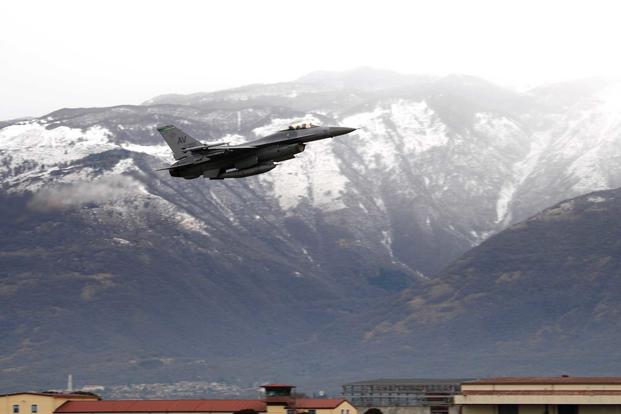A cutting-edge technology that can help prevent aircraft from flying into the ground may have just saved another pilot's life.
The U.S. Air Force is reviewing whether an F-16 Fighting Falcon's Automatic Ground Collision Avoidance System, known as Auto-GCAS, kicked in during a flight last month at Nellis Air Force Base, Nevada, according to the Air Force Safety Center.
Keith Wright, a center spokesman, said the review process could take up to three months as investigators compile data sources. "The Air Force remains focused on finalizing every review in a timely manner through a conclusive process that takes into account all available data related to the incident," he said via email.
Wright said Auto-GCAS has saved 10 lives in the F-16 community over the last few years. It has saved nine aircraft from crashing into the ground; one incident involved a two-seater aircraft, resulting in 10 lives saved to date, he said. The last confirmed save occurred in January 2020.
Auto-GCAS -- which is currently being fielded in the F-35 Joint Strike Fighter fleet -- was developed in the 1990s, but early versions had data issues.
It was re-engineered between 2003 and 2010 and has been in use by the Air Force's F-16 fleet since 2014. As of 2016, it had been installed on more than 600 F-16 aircraft, according to the service.
The system is "a flight control logic" that uses a digital terrain elevation database "to calculate the aircraft's relative position above the ground," Wright said.
"If it senses that the aircraft is on a collision course with the ground that is outside of normal parameters, it automatically commands the aircraft to roll wings level and executes a recovery to prevent flight into the ground," he said.
For example, if a pilot loses consciousness, the system kicks in. The sensors that feed into it take into consideration the terrain below, the aircraft's trajectory and speed, and the human inputs, or lack thereof, to calculate how best to recover the jet and return it to a smooth trajectory. Once the aircraft is at a safe altitude, the system will return control to the pilot.
In one dramatic episode reported in 2016, an Arizona Air National Guard pilot was saved after losing consciousness in the cockpit and entering a dive. Unclassified footage of the episode shows the aircraft headed for the ground like a missile before the system intervenes.
All newer F-16s -- Block 40s and above -- with digital flight controls have Auto-GCAS. Older F-16s, such as those with analog flight controls, will incorporate the system in the next couple of years.
Last year, units at Eglin Air Force Base, Florida, and Hill Air Force Base, Utah, began installing Auto-GCAS on the F-35A variant -- seven years ahead of schedule. The stealth jet test flights with the system began at Edwards Air Force Base, California, in 2018.
There have not been any F-35A saves to date, Wright said.
"Ninety-two percent of U.S. Air Force and Air National Guard F-35As have loaded Auto-GCAS capable software as of July 28," he added.
"The remaining F-35As -- minus two flight test aircraft -- will receive the capability by the end of the year," he said, explaining that those two aircraft are not equipped with Auto-GCAS-capable computers for the installation.
-- Oriana Pawlyk can be reached at oriana.pawlyk@military.com. Follow her on Twitter at @Oriana0214.
Related: Air Force F-35s Are Getting Ground Collision Avoidance Tech 7 Years Early












